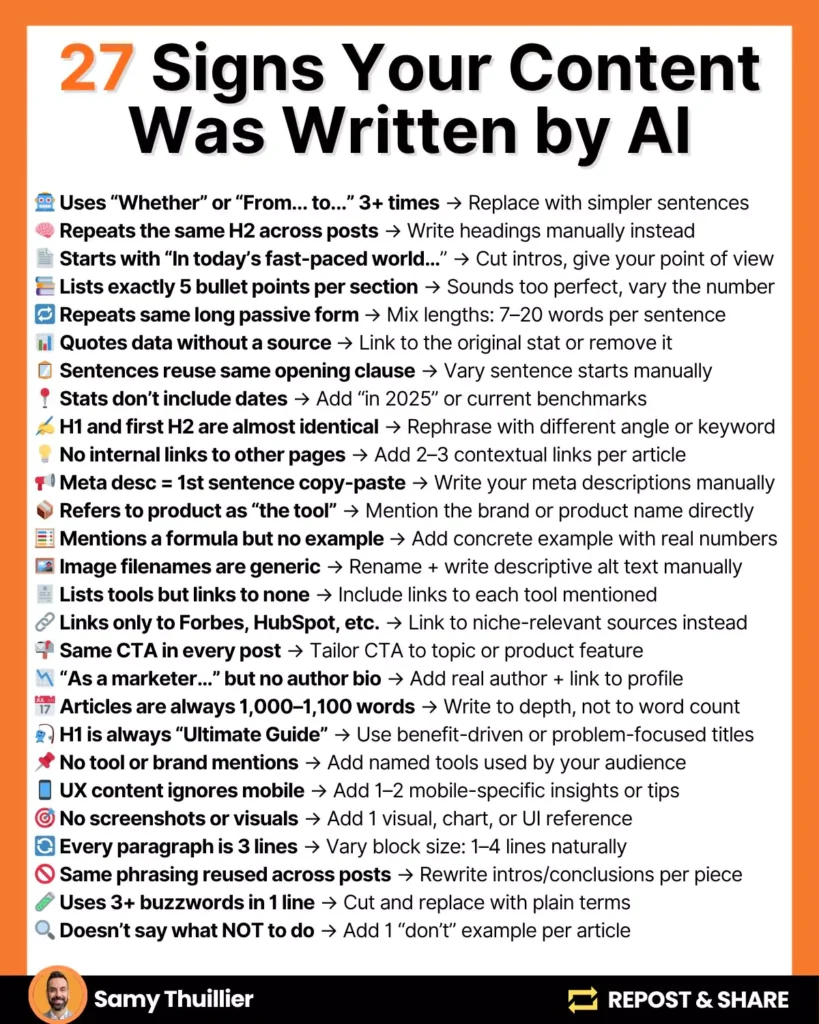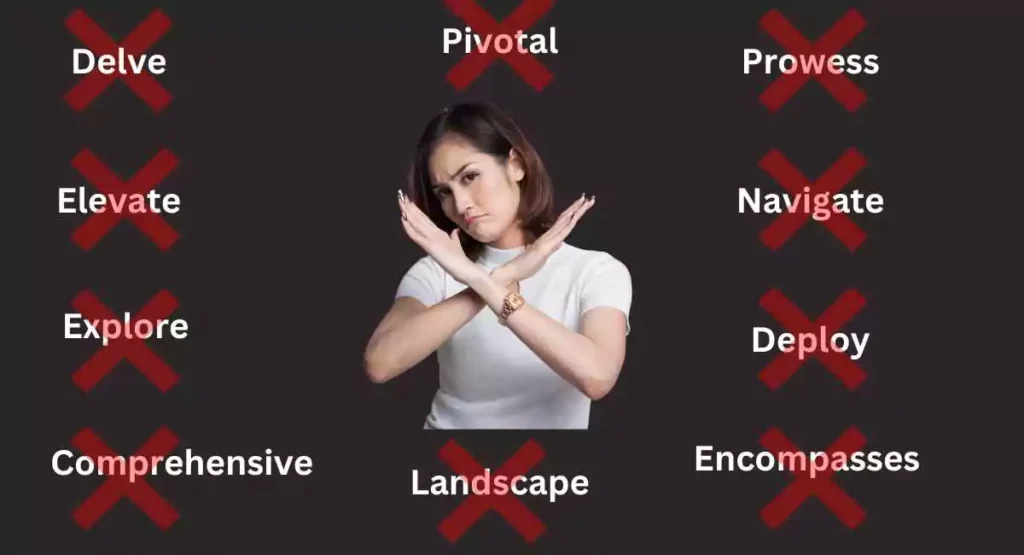Let’s be honest — most AI-written blog posts look great. Nice formatting. Good structure. All the SEO stuff in place. But somehow… they feel weird. Off. Like nobody really wrote them.
I recently came across this amazing post by Samy Thuillier, an SEO expert who reviewed 100+ blog posts. He found a pattern — content that was technically “good” but totally lifeless.
He pulled together 27 signs your content screams “Yep, AI did this!” — and if you’re using AI tools to write content, you need to read this list before hitting publish button.

1. Weird Sentence Patterns
- “Whether…” or “From… to…” 3+ times
→ It’s overcomplicated. Just simplify it. - Repeats the same passive voice
→ Mix short and long sentences. Some punchy. Some detailed. - Every sentence starts the same way
→ If every sentence starts with “In today’s world…” you’ve got a problem.
2. Intro & Headings That Sound Like a Robot

- Starts with “In today’s fast-paced world…”
→ Delete. Just say something real instead. - Every H2 is “Benefits of…”
→ Ugh. Write Headings manually instead. - “Ultimate Guide” titles for meh content
→ You can’t just slap “ultimate” on anything. - H1 & first H2 are almost the same
→ Make each heading earn its place.
3. Stats & Data — But With No Receipts
- No source links
→ If you quote a stat, link it. - No dates on data
→ Stats change fast. Add the year (“as of 2024”). - Mentions a formula but gives no example
→ Don’t just drop a method — walk us through it.
4. Structure Too Perfect? It’s Probably AI

- Exactly 5 bullet points per section
→ Sounds too clean. Try 3, 6, or 7. Mix it up. - Every paragraph is exactly 3 lines
→ Break the pattern. Write like a human. - Only 1,000–1,100 words every time
→ Focus on depth, not word count.
5. Lazy Tool & Product Mentions
- Says “the tool” or “the solution”
→ Just name the dang thing. Clarity > vagueness. - Lists tools but no links
→ If you mention them, link them. - Only links to big names (like HubSpot, Forbes)
→ Add niche or personal links too. - No tool or brand names at all
→ Readers want to know what real people are using.
6. Boring Meta Stuff
- Meta description is just the first line copy-pasted
→ Write a separate, engaging meta manually. - No internal links
→ Add 2–3 links to other posts or pages. Like this one:
AI writing tools are great, but they’re not done after the first draft. You’ve got to humanize them.
7. Missing Human Touch
- No author bio
→ Who wrote this? Readers want to know. Even a short blurb builds trust. - Says “As a marketer…” but doesn’t show proof
→ If you say you’re an expert, give a link to your profile or past work. - Refers to readers generically
→ Speak to the reader. Not like you’re broadcasting into space.
8. UX (User Experience) Failures
- No mobile-specific advice
→ Nearly 60% of readers are on phones. Add tips or notes for mobile users. - No visuals or screenshots
→ Not even one image or chart? Add something to break the wall of text. - Image filenames are generic
→ “Image123.jpg”? Nah. Rename with clear alt text for SEO (like “content-writing-checklist.png”).
9. Repetitive or Robotic Patterns
- Same phrases repeated across blog posts
→ If your intros and conclusions are copy-pasted templates, readers will notice. - Buzzword soup
→ “Leverage scalable synergy to optimize…” 😩 Kill it. Use plain words. - Doesn’t say what not to do
→ Don’t just tell people what to do — include 1 clear “don’t” in every guide.
If your content falls into any of these traps, here’s your fix-it list:
✅ Rewrite your intro with a real opinion
✅ Add internal links like this one
✅ Show real examples, visuals, and stats with sources
✅ Change your headings — every post should sound like you, not ChatGPT
✅ Use tools like Grammarly, Quillbot, ChatGPT or SurferSEO to polish it up
AI Should Help, Not Hurt
Look — AI writing isn’t bad. In fact, it’s incredibly useful. But too many people treat it like a final draft when it’s really just a starting point.
Your readers aren’t bots. Neither is Google.
They want clarity. Personality. And something real.
So the next time you use AI, run through this checklist by Samy Thuillier and ask yourself:
“Would I actually enjoy reading this?”
If the answer’s “meh,” then go back and fix the signals. Or better yet — get someone who can. 👉 Content Ladder, If you’re tired of editing the same robotic content over and over, give them a shout.
Save this post. Share it with your content team. Or print it out and tape it to your laptop.
Because boring AI content isn’t just annoying — it’s costing you clicks, trust, and conversions.
Let’s make the internet a little more human again.

